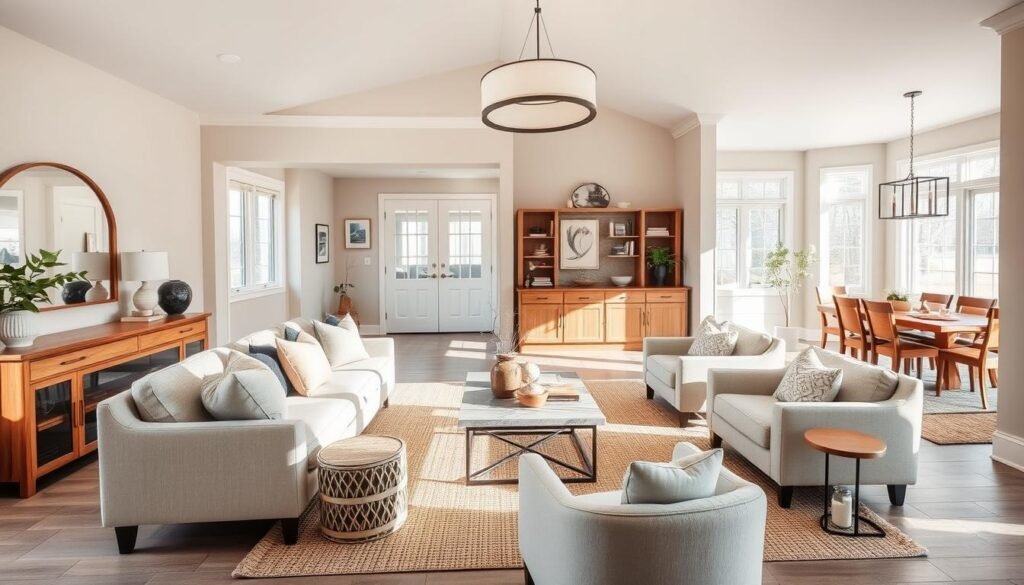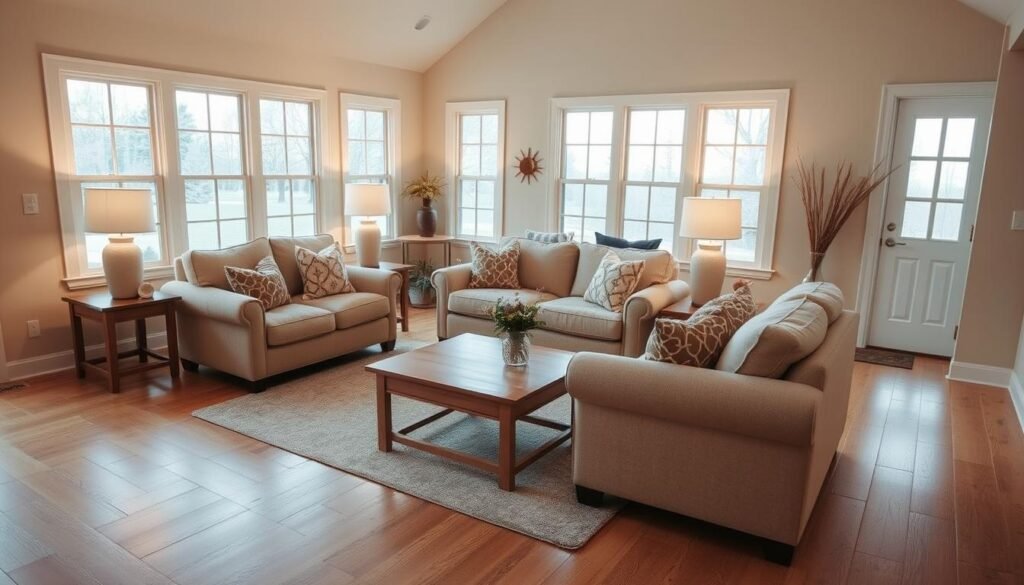This post may contain affiliate links. When you purchase through links on our site, we may earn an affiliate commission.
What if you could combine timeless elegance and modern simplicity without creating visual chaos? I’ve spent years answering this question through trial, error, and countless client projects. Let me show you how to master this balance in your home.
When I first explored blending classic details with clean lines, I discovered something magical: open layouts aren’t just about square footage. They’re canvases for creating emotional connections between spaces. My kitchen now flows seamlessly into my living area, yet each zone feels distinctly purposeful.
The secret lies in strategic design choices. Soft textures pair with structured furniture. Neutral palettes get energized through metallic accents. And those awkward corners? They become reading nooks that whisper comfort while maintaining sleek sophistication.
Key Takeaways
- Balance traditional warmth with contemporary minimalism using layered textures
- Create visual flow between kitchen and living areas through coordinated color schemes
- Use statement lighting to define zones without physical dividers
- Incorporate multifunctional furniture that serves style and practicality
- Mix organic materials like wood and stone for dimensional interest
Through this guide, I’ll share hard-won insights from designing 50+ open-concept spaces. You’ll learn how to avoid common pitfalls and create rooms that feel both curated and effortlessly livable. Ready to transform your space into a harmonious blend of yesterday’s charm and today’s functionality?
Introduction to My Transitional Design Journey
It took a decade of experiments to realize that harmony lies in restrained contrasts. My early projects leaned too traditional or overly modern—until I discovered designs that whisper rather than shout. This quiet confidence defines my approach today.
Embracing the Transitional Style
https://www.youtube.com/watch?v=FDWFW3mXuHM
I once redesigned a 1920s brownstone where sunlight revealed the magic of balanced interiors. Cream walls became canvases for walnut shelving, while linen drapes softened angular furniture. Natural light became my co-designer, highlighting textures without overwhelming.
A client once told me, “This feels like my grandmother’s house—but if she’d hired a minimalist.” That’s the essence of blending eras: familiar warmth meets curated simplicity.
| Traditional | Transitional | Modern |
|---|---|---|
| Ornate moldings | Clean-lined millwork | Concrete surfaces |
| Patterned wallpapers | Textured neutrals | Monochrome palettes |
| Formal layouts | Flexible zones | Open lofts |
Why Open Floor Plans Work Perfectly
Knocking down walls transformed a dark Philadelphia row house I redesigned last year. Suddenly, morning light reached the kitchen island, and conversations flowed between cooking and lounging areas. Functional layouts aren’t just trendy—they create homes that breathe.
Wood beams overhead tied the space together, while strategic lighting defined zones. The result? A family hub that feels expansive yet intimate, proving smart design beats square footage every time.
Design Principles and Key Elements
Have you ever walked into a room that feels both cozy and crisp? That’s the power of intentional design. My approach centers on three pillars: color harmony, tactile richness, and architectural dialogue. These elements work together to create spaces that feel collected over time, not decorated overnight.
Neutral Palettes and Textured Fabrics

Neutrals act as your design’s quiet foundation. I often start with warm greys or creamy whites, then layer in texture through fabrics. A velvet ottoman here, a nubby wool throw there—these choices add depth without visual noise.
In a recent project, linen drapes softened angular windows while a chunky knit rug anchored sleek furniture. “It’s like the walls are hugging me,” the client told me. That’s textured fabrics working their magic.
Mixing Traditional Charm with Modern Simplicity
Stone fireplaces gain new life when flanked by streamlined seating. I once paired century-old hardwood floors with a glass coffee table—the contrast made both elements shine brighter. Architectural features become focal points when balanced thoughtfully.
My go-to trick? Use organic materials as bridges. A reclaimed wood beam above stainless steel appliances. Marble countertops beside matte-black fixtures. These combinations feel both rooted and fresh.
When styling shelves, I mix leather-bound books with abstract sculptures. For walls, try a gallery of black-and-white photos in matching wood frames. This approach honors tradition while whispering modernity.
Transitional Decor for Open Floor Plans: Expert Techniques
Light reshapes rooms in ways we often underestimate. I’ve seen north-facing spaces transform through strategic material choices, and cramped areas breathe with clever spatial planning. Let’s explore techniques that make every square foot sing.

Maximizing Natural Light and Open Space
Sheer curtains became my secret weapon in a recent Chicago loft project. They filter sunlight while maintaining airiness—perfect for medium tone wood floors that add warmth without darkening the space. Mirrored accents near windows double the sunshine effect.
Consider pendant lights with open designs. A client’s kitchen glows with bronze fixtures that cast artistic shadows on tone wood floors. It’s functional art that enhances brightness.
Creating a Seamless Flow Between Zones
I define areas using texture shifts rather than walls. In one concept living room, terra-cotta tiles under the dining table transition to plush carpet near the sofa. The earthy palette keeps things cohesive.
Furniture legs matter more than you’d think. Slim-profile chairs in eating areas visually connect to low-slung sectionals. This creates rhythm without blocking sightlines.
Highlighting Architectural Features with Balance
Exposed beams get paired with sleek lighting in my designs. A historic home’s original floor brown floor became the star when complemented by minimalist furnishings. The key? Let one element shine while others play supporting roles.
Try framing arched doorways with tonal paint variations. It subtly emphasizes structure without overwhelming. For modern builds, I’ll add wainscoting beside industrial staircases—a nod to tradition that grounds contemporary spaces.
Styling and Furnishing Ideas for a Cohesive Look
Ever wonder how some spaces feel perfectly pulled together? The magic happens when every piece works in harmony. I’ve found that furniture selection and texture play lead roles in achieving this balance—especially in open layouts where every choice gets noticed.

Selecting the Right Furniture and Layout
Start with anchor pieces that ground the space. A streamlined sofa with tapered wood legs works wonders in medium tone settings. I recently placed one opposite a vintage cabinet in a client’s living room—the mix of eras created instant character without clutter.
Keep walkways clear in open concept areas. Angle chairs slightly toward conversation zones rather than rigidly against walls. This subtle shift makes rooms feel inviting while maintaining flow.
Layering Textures and Incorporating Accent Pieces
Texture is your secret weapon. Try a nubby jute rug under a glossy side table. Add linen throw pillows to leather seating—the contrast feels intentional yet effortless. In kitchens, I’ll pair smooth marble counters with woven barstools for tactile interest.
Wood floor beige tones act as natural neutrals. Layer them with tone wood accents like walnut bowls or oak frames. For brown floor spaces, introduce metallic decor in brass or copper to add warmth without darkening the room.
One client transformed their space by swapping bulky curtains for sheer panels. Suddenly, sunlight danced across their wood floor, making the whole area feel airier. Small changes, big impact.
Conclusion
Designing spaces that bridge eras taught me one truth: great interiors tell stories without words. Through layered textures and intentional contrasts, we craft homes that feel both fresh and familiar. The magic lies in letting materials speak—light wood flooring whispering warmth beneath sleek furnishings, dark wood accents adding depth to airy layouts.
Remember, quality foundations matter most. Choose surfaces that age gracefully and harmonize tones across zones. In mid-sized transitional projects, balance is key—pair substantial pieces with negative space, let natural light amplify your palette. Those brown undertones in woodwork? They’re secret connectors that unite kitchen and living areas.
Ready to reimagine your space? Start with one statement piece—a sculptural lamp or heirloom rug—and build outward. And if you feel stuck, my door’s always open. After all, the best rooms evolve through thoughtful experimentation, just like we do.





 using WordPress and
using WordPress and 
No responses yet